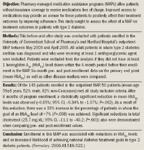- Safety & Recalls
- Regulatory Updates
- Drug Coverage
- COPD
- Cardiovascular
- Obstetrics-Gynecology & Women's Health
- Ophthalmology
- Clinical Pharmacology
- Pediatrics
- Urology
- Pharmacy
- Idiopathic Pulmonary Fibrosis
- Diabetes and Endocrinology
- Allergy, Immunology, and ENT
- Musculoskeletal/Rheumatology
- Respiratory
- Psychiatry and Behavioral Health
- Dermatology
- Oncology
Effect of a medication assistance program on clinical outcomes in patients with diabetes
Approximately 17 million people in the United States have type 2 diabetes, and the prevalence continues to rise.1 More than 45% of patients with end-stage renal disease have type 2 diabetes as an etiology, and a patient with type 2 diabetes has the same risk of developing an acute coronary syndrome (unstable angina, myocardial infarction [MI]) over the next 10 years as someone who has had an acute coronary syndrome in the past.2 In addition to these complications, type 2 diabetes also increases the risk of blindness, neuropathy, and amputation.3
Approximately 17 million people in the United States have type 2 diabetes, and the prevalence continues to rise.1 More than 45% of patients with end-stage renal disease have type 2 diabetes as an etiology, and a patient with type 2 diabetes has the same risk of developing an acute coronary syndrome (unstable angina, myocardial infarction [MI]) over the next 10 years as someone who has had an acute coronary syndrome in the past.2 In addition to these complications, type 2 diabetes also increases the risk of blindness, neuropathy, and amputation.3
Studies repeatedly have demonstrated that improved glycemic control benefits patients with diabetes.4,5 In fact, for each percentage point reduction in glycosolated hemoglobin A1c (HbA1c) (eg, from 8.0% to 7.0%), a patient's risk of MI and microvascular complications has been shown to decrease by 16% and 25%, respectively.5

METHODS
Program description. The MAP evaluated in this study has been thoroughly described in a previous publication7 and therefore will be reviewed only briefly here.
The pharmacy-managed MAP was established in cooperation with University of Connecticut's School of Pharmacy in August 2002. Patients are referred to the program through the outpatient social services department, generally after patient applications for state entitlements are denied. On referral, patients are interviewed to obtain demographic, medication, financial, and insurance information and are assisted by program staff in completing and submitting applications to pharmaceutical manufacturers (an average of 4 hours per week is spent on such tasks). Eligibility criteria and enrollment requirements to obtain free medications from manufacturers vary but generally include documentation of limited income, lack of prescription drug coverage, and ineligibility for other forms of both public and private assistance. It is important to note that most medications obtainable through manufacturers' programs are "branded," with access to generic drugs available only through a few programs (ie, Rx Outreach). Only medications for chronic disease states, such as diabetes or hyperlipidemia, are sought. Prescribers are consulted to discuss the patient's current and future drug needs and to complete their sections of applications.
Manufacturer approval of applications and shipping of drugs generally takes 4 to 6 weeks. To address this lag time in receiving pharmaceuticals, those patients thought to be eligible are immediately authorized to receive medication for which they applied, free of charge, from the outpatient pharmacy. Patients typically are approved for 3-month intervals by manufacturer programs.
After initial patient enrollment in the MAP, patients are scheduled to return to the program office on a quarterly basis to be reassessed for eligibility, to identify newly prescribed and eligible medications, and to complete renewal applications and update financial documentation. Patients are contacted via telephone when renewal appointments need to be set or when additional information is required for manufacturer approval.
